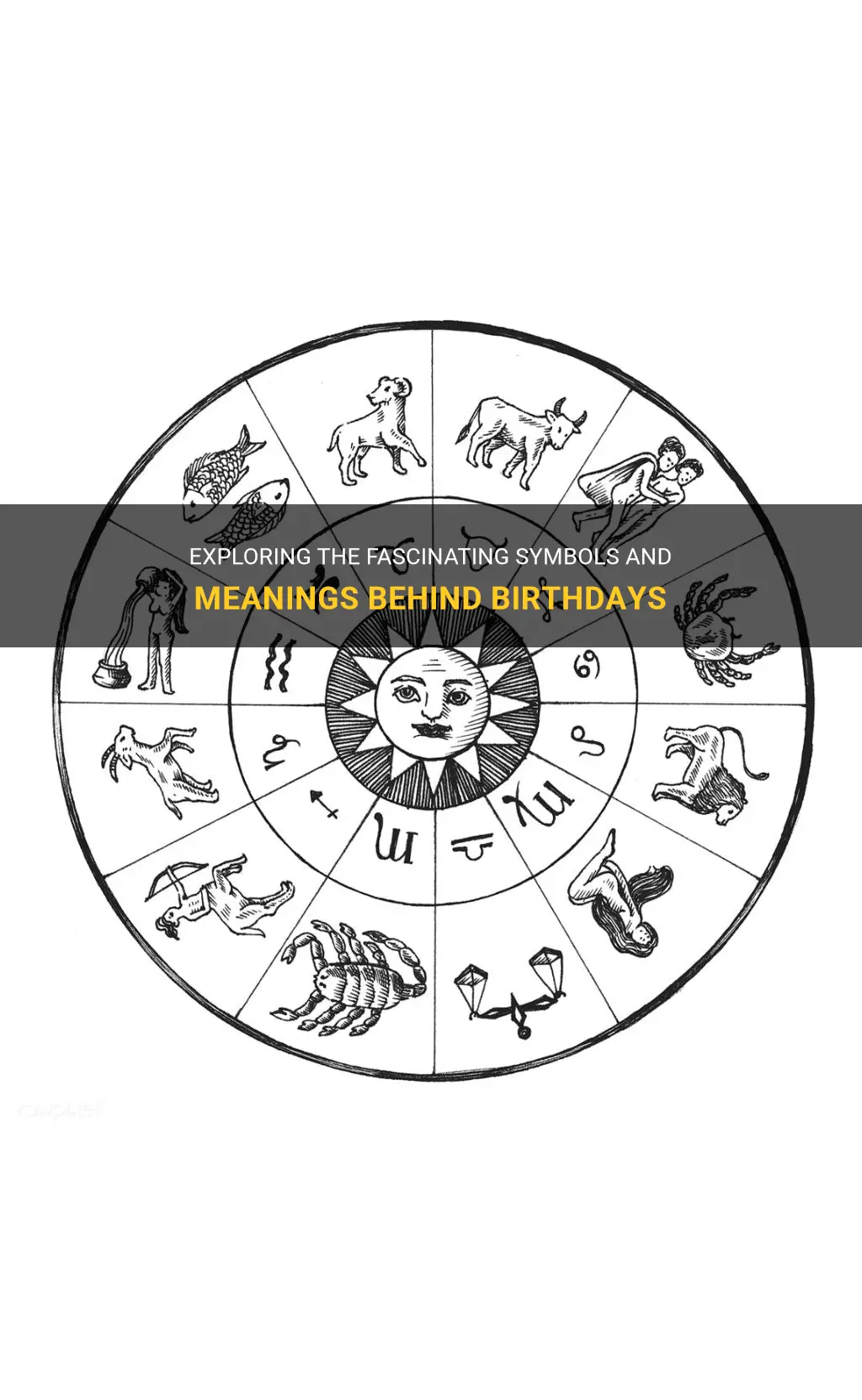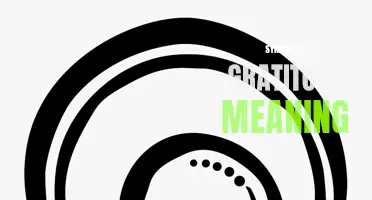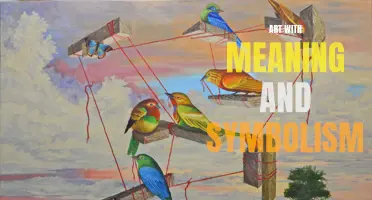
Each year, as we blow out the candles on our birthday cake, we may not realize the hidden significance behind the symbols and rituals associated with this special day. Birthdays have long been celebrated as a significant milestone in a person's life, and throughout history, various symbols and traditions have emerged to mark this joyous occasion. From the candles that represent the years gone by to the cutting of the cake, which symbolizes the sharing of prosperity, birthdays are rich in symbolism and meaning. Join us as we delve into the fascinating world of birthday symbols and uncover the hidden messages behind these cherished traditions.
What You'll Learn
- What are some common birthday symbols and their meanings?
- Are there any specific colors that are associated with birthdays and their significance?
- What are some traditional birthday symbols and their cultural origins?
- How have birthday symbols and meanings evolved over time?
- Is there a significance to the number of candles on a birthday cake?

What are some common birthday symbols and their meanings?
Birthdays are special occasions that are celebrated around the world. Many cultures have their own unique traditions and symbols associated with birthdays. These symbols often carry deep meanings and serve to honor and commemorate the person's special day. Here are some common birthday symbols and their meanings.
- Birthday Cake: The birthday cake is perhaps the most recognizable symbol of birthdays. It represents the joy and celebration of the occasion. Candles are usually placed on the cake, with one candle for each year of the person's age. When the candles are lit and blown out, it is believed that the person is making a wish that will come true in the coming year.
- Balloons: Balloons are often used as decorations during birthday parties. They symbolize fun, happiness, and the feeling of being uplifted. The vibrant colors of the balloons add to the festive atmosphere of the celebration. Balloons are also often given as gifts, expressing the sender's wishes for a cheerful and joyous year ahead.
- Presents: The act of giving and receiving presents on birthdays has a symbolic meaning. It represents the love and thoughtfulness of friends and family towards the birthday person. The choice of a gift can also carry significance, reflecting the interests, desires, or needs of the recipient. Presents are a way of showing appreciation and celebrating the individual's uniqueness and worth.
- Birthday Cards: Birthday cards are a popular way of expressing birthday wishes. They often feature images or words that convey heartfelt messages of love, friendship, and well-wishes. The act of giving and receiving a birthday card signifies the importance of the person's presence in the sender's life and serves as a reminder of their bond.
- Flowers: Flowers are a timeless symbol of beauty and love. They are often given as birthday gifts, symbolizing affection and adoration for the person celebrating their birthday. Different flowers have different meanings, such as roses symbolizing love and passion, daisies representing innocence and purity, and sunflowers symbolizing warmth and happiness. The choice of flowers can convey specific emotions and sentiments towards the birthday person.
- Birthday Wishes: Birthday wishes are messages or blessings that are sent to the birthday person. Whether written in a card, spoken in person, or sent through social media, these wishes symbolize good luck and happiness for the coming year. Birthday wishes are often heartfelt and personalized, expressing the sender's genuine love and support for the individual.
Birthdays are a time for celebration, reflection, and appreciation. The symbols associated with birthdays serve as reminders of the joy and love that surround these special occasions. Whether it's blowing out candles on a cake, receiving presents, or reading heartfelt birthday wishes, these symbols add depth and meaning to the celebration of life.
Decoding the Meaning Behind Mickey's Beer Cap Symbols
You may want to see also

Are there any specific colors that are associated with birthdays and their significance?
When it comes to birthdays, many people like to incorporate colors into their celebrations. Colors can help set the mood and create a festive atmosphere. While there are no specific colors that are universally associated with birthdays, there are some colors that are commonly used and have symbolic significance.
One of the most commonly used colors for birthdays is, of course, the color "birthday" itself - which is usually associated with bright, fun colors like pink, blue, and yellow. These colors are often used in decorations, party hats, and wrapping paper.
In addition to the color "birthday," there are also some traditional colors associated with specific birthday milestones. For example, the color pink is often associated with baby girls and is used to celebrate their first birthdays. Blue, on the other hand, is commonly associated with baby boys and is used for their first birthdays as well.
As children get older, other colors come into play. For example, the color yellow is often associated with joy and happiness and is commonly used for children's birthdays. Green is a color that represents growth and new beginnings, so it is often used for milestone birthdays like turning 18 or 21.
For adults, it is common to use more sophisticated colors for birthday celebrations. Black and gold are often used to create an elegant and glamorous atmosphere. Silver is also a popular color for adult birthdays, as it represents wisdom and maturity.
It's worth noting that different cultures may have their own traditions and colors associated with birthdays. For example, in some cultures, the color red is considered lucky and is used for birthdays. In other cultures, white is the color of choice, as it represents purity and new beginnings.
Ultimately, the choice of colors for a birthday celebration is up to the individual or the cultural traditions they follow. The most important thing is to choose colors that create a joyful and festive atmosphere and make the birthday person feel special. Whether it's pink, blue, yellow, or any other color, the significance comes from the love and celebration expressed during the birthday festivities, rather than the specific colors themselves.
Decoding the Symbols on Oral-B iO Brush Head: What Do They Mean?
You may want to see also

What are some traditional birthday symbols and their cultural origins?
Birthday celebrations are an important event in cultures around the world. They are a time to gather with loved ones, reflect on the past year, and look forward to the future. Alongside cakes, balloons, and presents, there are several traditional birthday symbols that are deeply rooted in cultural history. These symbols often hold significance and meaning specific to a certain culture or region.
One of the most well-known birthday symbols is the birthday cake. The tradition of celebrating with a cake can be traced back to ancient Greece, where round or moon-shaped cakes were offered to Artemis, the goddess of the moon, as a way of honoring her. Over time, this symbol transformed into the modern birthday cake we know today. Candles on a birthday cake also have a long history. The ancient Greeks believed that fire had a mystical quality, and by lighting candles on a cake, they believed they were sending prayers to the gods. Today, blowing out candles and making a wish has become a universally recognized birthday tradition.
Another common birthday symbol is the balloon. Balloons have become a popular decoration for birthday parties, adding color and festivity to the celebration. The use of balloons in birthday celebrations can be traced back to ancient Aztec culture, where they were used as offerings to the gods during religious ceremonies. In modern times, balloons have become a symbol of joy and celebration, and are often associated with birthdays and other special occasions.
Another birthday symbol with cultural origins is the birthday song. The most commonly sung birthday song, "Happy Birthday to You," has its roots in the late 19th century. The lyrics were originally written by two sisters, Patty and Mildred Hill, and the melody is believed to have been adapted from an earlier song called "Good Morning to All." Today, the "Happy Birthday" song is sung in various languages and cultures around the world, making it a unifying symbol of birthdays worldwide.
In some cultures, specific flowers or plants are associated with birthdays. For example, in the United States, the birth flower for January is the carnation, which symbolizes love and admiration. In Japan, the cherry blossom is often associated with April birthdays, as it represents the transience of life and the beauty of nature. These floral symbols add a personal touch to birthday celebrations and can be used as gifts or decorations.
Finally, the concept of age is also a significant symbol in birthday celebrations. In many cultures, reaching certain milestone ages, such as 18 or 21, is cause for special celebration. Different cultures have different customs and rituals for celebrating these milestones. For example, in Latin American cultures, a young woman's 15th birthday, known as a quinceañera, is a grand and elaborate celebration that marks her transition into adulthood. These cultural symbols of age reflect the values and traditions of a particular society.
In conclusion, birthday symbols have deep cultural origins and hold significant meaning in various cultures around the world. From birthday cakes and candles to balloons and songs, these symbols add a sense of joy and tradition to birthday celebrations. Whether it be the ancient Greek belief in offering cakes to the gods or the Aztec tradition of using balloons in religious ceremonies, these symbols have evolved over time to become cherished traditions in modern-day birthday celebrations. They serve as reminders of our cultural heritage and the importance of celebrating life's milestones with loved ones.
Exploring the Rich Symbolism and Meanings of German Cultural Symbols
You may want to see also

How have birthday symbols and meanings evolved over time?
Over the course of history, birthday celebrations have evolved with various symbols and meanings associated with them. From ancient traditions to modern customs, birthdays have been a way for people to mark the passing of time and honor the individuals celebrating their special day.
In ancient civilizations, birthday celebrations were primarily reserved for royalty and high-ranking individuals. These celebrations often involved lavish feasts and grand gatherings. Birthdays were seen as significant milestones, symbolizing the growth and maturation of an individual. However, the concept of birthdays as we know them today didn't truly emerge until centuries later.
During the Middle Ages, birthdays lost much of their significance due to the influence of Christianity. The Church discouraged the celebration of birthdays, considering them pagan and self-indulgent. Instead, saints' days and religious festivals took precedence. This shift in focus minimized the importance of individual birthdates and instead emphasized communal celebrations.
It wasn't until the 18th century that birthdays started regaining their significance in Western culture. The rise of the middle class and the democratization of birthday celebrations allowed ordinary individuals to commemorate their special day. The Industrial Revolution played a significant role in this shift, as it brought about increased wealth and leisure time for many people.
With the reintroduction of birthday celebrations, various symbols began to emerge as meaningful representations of the occasion. Candles, for example, became a popular symbol associated with birthdays. The tradition of placing candles on a birthday cake can be traced back to ancient Greece, where people believed that the smoke carried their wishes and prayers to the gods. The number of candles on the cake often represents the age of the person celebrating their birthday.
The song "Happy Birthday to You" also became a common symbol associated with birthdays. The origins of the song can be traced back to the late 19th century, and it has since become the most recognized song in the English language. Singing this song has become a traditional ritual during birthday celebrations, often accompanied by the presentation of the birthday cake and the blowing out of candles.
In modern times, birthday symbols and meanings have continued to evolve. Balloons, streamers, and party hats have become popular decorations, adding a festive and celebratory atmosphere to the occasion. The giving of gifts has also become a common practice, symbolizing love, appreciation, and well wishes for the person celebrating their birthday.
Overall, the evolution of birthday symbols and meanings reflects the changing attitudes and cultural values of different time periods. Whether it be through ancient feasts, religious festivals, or modern-day parties, birthdays have always held a special place in human society as a way to honor and celebrate the individuals who are marking another year of life.
Decoding Car Air Conditioning Symbols: Understanding the Meaning Behind the Icons
You may want to see also

Is there a significance to the number of candles on a birthday cake?
Birthdays are a special occasion that people celebrate to mark the anniversary of their birth. One of the most iconic symbols of a birthday celebration is the birthday cake adorned with candles. However, have you ever wondered if there is any significance to the number of candles on a birthday cake?
The tradition of placing candles on a birthday cake dates back to ancient Greece. The Greeks believed that the smoke from the candles carried their prayers and wishes to the gods. They often lit candles on round cakes, representing the full moon, which was considered a symbol of the goddess Artemis.
As this tradition spread throughout Europe, it evolved into the practice of putting candles on a birthday cake. The number of candles typically represented the age of the person celebrating their birthday. It was customary to have one candle for each year of life, and an additional candle to symbolize good luck for the coming year.
Blowing out the candles on a birthday cake has its own significance. It is believed that by blowing out the candles, the birthday person is making a wish. The smoke rising from the extinguished candles carries their wish up to the heavens, where it will hopefully come true.
In modern times, the tradition of placing candles on a birthday cake has become more symbolic than ever. While the number of candles still represents the age of the birthday person, it can also serve as a visual representation of their journey through life. Each candle can be seen as a milestone or a year filled with memories and experiences.
Additionally, the number of candles on a birthday cake can also be a fun way to guess the age of the birthday person. It can spark conversations and create a sense of excitement and anticipation. It can also be an opportunity for others to reflect on their own ages and life experiences.
In recent years, however, some people have started using candles in a different way. Instead of placing individual candles, they use a single candle referred to as a "magic candle" or a "trick candle." These candles relight themselves after being blown out, adding an element of surprise and amusement to the birthday celebration.
In conclusion, the number of candles on a birthday cake carries both traditional and symbolic significance. It represents the age of the birthday person and can also serve as a visual representation of their journey through life. Blowing out the candles is believed to make a wish that will hopefully come true. Whether it is the traditional practice of placing individual candles or the use of a trick candle, the candles on a birthday cake add a spark of joy and excitement to the celebration.
Decoding the Meaning of the Triangle Symbol with an Exclamation Point
You may want to see also
Frequently asked questions
The birthday cake is considered a symbol of celebration because it is a focal point of the birthday festivities. It is often decorated with candles, representing the age of the person celebrating, and is usually served after a meal or during a party. The act of blowing out the candles and making a wish is seen as a joyful and festive moment, which is why the birthday cake is seen as a symbol of celebration.
Birthday candles have a symbolic meaning as they represent the age of the person celebrating their birthday. Each candle on the cake typically represents one year of the person's life. The act of blowing out the candles is often accompanied by making a wish, which is believed to bring good luck and positive energy for the coming year.
The color blue is often associated with birthdays, especially for boys, because it has historically been associated with masculinity. Blue is also seen as a calming and peaceful color, so it is often used to create a serene and relaxing atmosphere during birthday celebrations. Additionally, blue is often used to represent the sky and ocean, which are both vast and expansive, symbolizing the potential and possibilities of the year ahead.
Birthday balloons are often used as decorations during birthday celebrations and hold various symbolic meanings. The colorful and vibrant nature of balloons represents joy, happiness, and celebration. They also symbolize the idea of letting go and releasing negativity, as they can be filled with air and then released into the air. Balloons can also represent the idea of "floating on air" or feeling light and carefree on your birthday.







